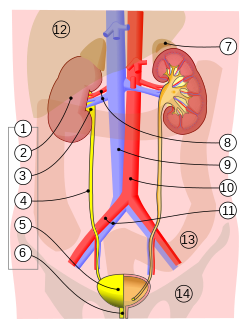| Ureter (Schematic View) | |
|---|---|
 |
|
| 1. Human urinary system: 2. Kidney, 3. Renal pelvis, 4. Ureter, 5. Urinary bladder, 6. Urethra. (Left side with frontal section), 7. Adrenal gland Vessels: |
In human anatomy, the ureters are tubes made of smooth muscle fibers that propel urine from the kidneys to the urinary bladder. In the adult, the ureters are usually 25–30 cm (10–12 in) long and ~3-4 mm in diameter.
In humans, the ureters arise from the renal pelvis on the medial aspect of each kidney before descending towards the bladder on the front of the psoas major muscle. The ureters cross the pelvic brim near the bifurcation of the iliac arteries (which they cross anteriorly). This is a common site for the impaction of kidney stones (the others being the ureterovesical valve, where the ureter meets the bladder, and the pelvouteric junction, where the renal pelvis meets the ureter in the renal hilum). The ureters run posteroinferiorly on the lateral walls of the pelvis and then curve anteriormedially to enter the bladder through the back, at the vesicoureteric junction, running within the wall of the bladder for a few centimetres. The backflow of urine is prevented by valves known as ureterovesical valves.
In females, the ureters pass through the mesometrium and under the uterine arteries on the way to the urinary bladder. An effective phrase for remembering this anatomical relationship is "water (ureters) under the bridge (uterine arteries or vas deferens)."
Ureters are also found in all other amniote species, although different ducts fulfill the same role in amphibians and fish.[1]
| Ureter (Anatomical View) | |
|---|---|
 |
|
| Artery | Superior vesical artery, Vaginal artery, Ureteral branches of renal artery |
| Precursor | Ureteric bud |
| MeSH | Ureter |
| Dorlands/Elsevier | Ureter |
Contents |
Disorders [link]
Cancer of the ureters is known as ureteral cancer.
A kidney stone can move from the kidney and become lodged inside the ureter, which can block the flow of urine, as well as cause a sharp cramp in the back, side, or lower abdomen.[2] The affected kidney could then develop hydronephrosis, should a part of the kidney become swollen due to blocked flow of urine.[3] There are three sites where a kidney stone will commonly become stuck:
- at the ureteric junction of renal pelvis;
- as the ureter passes over the iliac vessels;
- where the ureter enters into the urinary bladder (vesicoureteric junction).
Clinical [link]
The ureter is sometimes injured during hysterectomies, near the infundibulopelvic (suspensory) ligament or where the ureter courses posterior to the uterine vessels.[4]
References [link]
- ^ Romer, Alfred Sherwood; Parsons, Thomas S. (1977). The Vertebrate Body. Philadelphia, PA: Holt-Saunders International. p. 378. ISBN 0-03-910284-X.
- ^ "Symptoms of Kidney Stones". MedicalBug. 1 January 2012. https://www.medicalbug.com/symptoms-of-kidney-stones/. Retrieved 11 April 2012.
- ^ Resnick, Martin I; Lam, Mildred; Zipp, Thomas (4 September 2009). "Kidney Stones". NetWellness. https://www.netwellness.org/healthtopics/kidney/kidneystones.cfm. Retrieved 11 April 2012.
- ^ Santucci, Richard A. "Ureteral Trauma". Medscape. https://emedicine.medscape.com/article/440933-overview#showall. Retrieved 11 April 2012.
External links [link]
- SUNY Labs 40:06-0111 - "Posterior Abdominal Wall: Internal Structure of a Kidney"
- SUNY Figs 43:08-02 - "Relationship of the ureter to the uterine artery."
- SUNY Figs 44:02-01 - "Mid-sagittal section of male pelvis."
- SUNY Anatomy Image 8923
- SUNY Anatomy Image 8945
- Virtual Slidebox at Univ. Iowa Slide 444
- Organology at UC Davis Urinary/mammal/ureter/ureter1 - "Mammal, ureter (LM, Medium)"
- Histology at KUMC urinary-renal15 - "Ureter"
- Cross section at UV pelvis/pelvis-female-17
Additional images [link]
-
Vertical section of kidney
|
|||||||||||||||||||||||||||||||||||||||||||||||||||||||||||||
|
||||||||||||||||||||||||||||||||||||||||



















